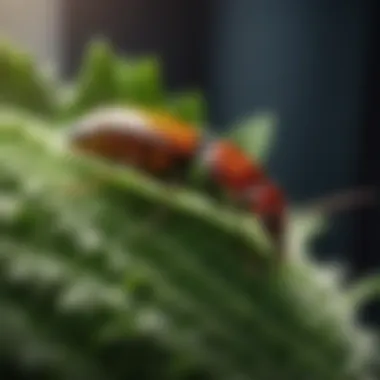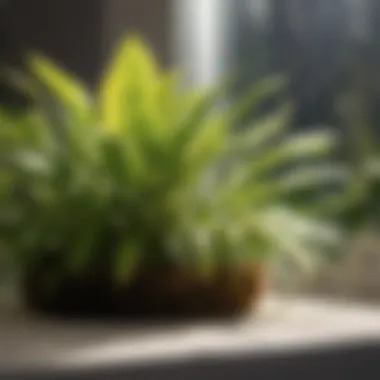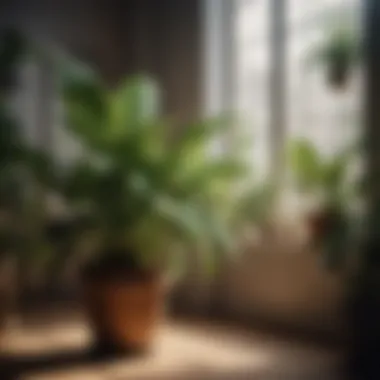Effective Strategies for Identifying and Managing Indoor Plant Pests


Materials:
- Magnifying glass: For close inspection of pests on indoor plants
- Cotton swabs: Used to apply remedies or treatments to affected areas
- Horticultural soap: Effective in controlling certain types of pests
- Neem oil: Natural remedy for various plant pests
DIY Steps:
- Identification: Begin by closely examining your indoor plants using a magnifying glass to spot any pests.
- Research: Look up common pests that affect indoor plants to determine the type of infestation.
- Treatment Selection: Choose the appropriate remedy based on the identified pests, such as horticultural soap or neem oil.
- Application: Use a cotton swab to apply the chosen treatment to the affected areas of the plants.
Technical Aspects:
- Tools: Magnifying glass, cotton swabs
- Timing: Perform pest management activities as soon as signs of infestation are detected to prevent further damage.
- Critical Techniques: Ensure thorough application of treatments and consistent monitoring of plant health.
DIY Project Process:
- Identification and Research: Use the magnifying glass to check for pests and research their typical behavior.
- Treatment Application: Apply horticultural soap or neem oil carefully to the affected parts of the plant.
- Monitoring: Regularly inspect plants to check for any new signs of infestation and reapply treatment if necessary.
Troubleshooting Tips:
- If treatments are not effective, consider changing the type of remedy used.
- Increase ventilation around plants to deter certain pests.
Introduction
Indoor plants can bring life and vibrancy to any space, but along with their beauty comes the risk of pest infestations. Understanding and managing these pests is crucial to maintaining the health and thriving of indoor plants. In this article, we will delve into the intricacies of indoor plant pests, exploring common types of pests and their impact on plant health.
Overview of Indoor Plant Pests
When it comes to indoor plants, pests can come in various forms, each posing a unique threat to the plants' well-being. Common types of pests such as aphids, spider mites, fungus gnats, and scale insects can wreak havoc on plant foliage and overall health. Identifying these pests early on is key to implementing effective management strategies to protect indoor plants from damage.
Common types of pests
Common indoor plant pests like aphids are small, sap-sucking insects that multiply rapidly and feed on plant juices. Their presence can result in distorted growth, yellowing of leaves, and overall plant decline. Spider mites, on the other hand, are tiny arachnids that produce webbing on plants, causing stippling and deformed leaves. Understanding the unique characteristics of each pest is essential in formulating targeted control measures.


Impact on plant health
The presence of pests on indoor plants can have detrimental consequences on their health. Pests can weaken plants by draining essential nutrients, leading to wilting, stunted growth, and in severe cases, plant death. Additionally, pests can act as vectors for diseases, further compromising the plant's well-being. Recognizing the impact of these pests allows plant owners to take proactive steps in pest management.
Importance of Pest Management
Effective pest management is vital in preserving the vitality of indoor plants and preventing widespread infestations that can be challenging to control. By focusing on preventing infestations and minimizing damage, plant owners can safeguard their green companions from the threats posed by pests.
Preventing infestations
Prevention is often the best approach when it comes to managing indoor plant pests. Implementing cultural practices such as proper watering techniques, maintaining good air circulation, and regular cleaning can create an environment that is less attractive to pests. By addressing potential entry points and minimizing pest access to plants, infestations can be significantly reduced.
Minimizing damage
In the unfortunate event of a pest infestation, the key lies in minimizing the damage caused to indoor plants. Swift action through the use of natural remedies like neem oil sprays or introducing beneficial insects like ladybugs for aphid control can help curb pest populations. By adopting a multifaceted approach that combines prevention and intervention strategies, plant owners can effectively manage pests and limit the impact on plant health.
Identification of Indoor Plant Pests
Visual Signs of Infestation
Leaf Damage
Leaf damage is a critical visual sign that indicates the presence of pests on indoor plants. It manifests in various forms such as holes, discoloration, wilting, or curling of leaves. This characteristic damage is a key indicator of pest infestation, alerting plant owners to take necessary action promptly. Recognizing leaf damage is essential for plant maintenance, as it provides insight into the type of pest affecting the plant and guides the selection of appropriate management strategies. Despite being a concerning aspect for plant owners, understanding leaf damage equips individuals with the knowledge needed to address pest issues efficiently.
Webbing or Silk Threads
The presence of webbing or silk threads on indoor plants is another visual indicator of pest infestation. Certain pests, such as spider mites or caterpillars, leave behind noticeable webbing or silk threads as they feed on plant tissues. These structures not only signify pest activity but also play a role in the reproduction and movement of pests throughout the plant. Identifying webbing or silk threads assists in pinpointing the specific pest responsible for the infestation and aids in devising targeted pest control measures. By paying attention to these visual cues, plant owners can intervene timely and safeguard their indoor plants from further damage.
Common Pests Encountered
Exploring the array of common indoor plant pests encountered underscores the diverse challenges faced by plant enthusiasts. Fungus Gnats, characterized by their small size and hovering behavior around plants, are a prevalent nuisance for indoor gardens. Mealybugs, with their white waxy coating and tendency to cluster on plant stems, pose a threat to plant health. Spider Mites, known for their webbing and rapid reproduction rates, can devastate plant populations if left unchecked. Additionally, Scale Insects, identified by their protective shells and sap-sucking feeding habits, present a persistent challenge to indoor plant vitality. Understanding the unique characteristics and behaviors of these common pests is crucial for effective pest management strategies, ensuring the protection and longevity of indoor plants.


Preventive Measures
Preventive measures are crucial in the effective management of pests on indoor plants. By implementing proactive strategies, plant owners can significantly reduce the risk of infestations and the subsequent damage to their beloved green companions. Preventive measures not only safeguard the health and vitality of indoor plants but also promote a sustainable and natural approach to pest control. Understanding the specific elements of preventive measures is essential for a successful indoor plant care routine. It is important to consider factors such as the environment, plant species, and potential pest threats when devising a preventive plan.
Cultural Practices
Cultural practices play a key role in preventing pest infestations and maintaining the overall health of indoor plants. Two fundamental cultural practices that are highly effective in pest management are proper watering techniques and regular cleaning and inspection.
Proper Watering Techniques
Proper watering techniques are essential for indoor plant care as they directly impact the plant's health and resilience against pests. Overwatering can create favorable conditions for pests such as fungus gnats, while underwatering can weaken the plant's defenses. Consistency in watering schedules, allowing the soil to dry slightly between waterings, and using appropriate watering methods tailored to each plant species are key characteristics of proper watering techniques. This approach ensures optimal moisture levels for plant growth and minimizes the risk of pest infestations, making it a popular and beneficial choice for indoor plant enthusiasts. While proper watering techniques promote plant health, excessive moisture can lead to root rot and other issues, emphasizing the importance of precision and moderation in watering practices.
Regular Cleaning and Inspection
Regular cleaning and inspection are essential components of pest management for indoor plants. Removing dust and debris from plant leaves reduces the presence of pests and their hidden habitats. Inspecting plants regularly for signs of pest infestations, such as webbing or sticky residues, allows for early detection and intervention. The key characteristic of regular cleaning and inspection is the proactive approach to identifying and addressing pest issues before they escalate. This practice is a popular choice among plant owners due to its effectiveness in preventing infestations and minimizing damage. However, excessive cleaning or handling of plants can stress them and lead to decreased vitality, highlighting the importance of balanced maintenance routines.
Natural Remedies and Biocontrols
Incorporating natural remedies and biocontrols into pest management strategies enhances the sustainability and effectiveness of indoor plant care. These methods offer safe alternatives to chemical treatments and promote ecological balance within indoor environments. Two notable examples of natural remedies and biocontrols commonly used by plant enthusiasts are Neem oil spray and Ladybugs for aphid control.
Neem Oil Spray
Neem oil spray is a versatile and natural solution for controlling a wide range of pests, including aphids, mealybugs, and spider mites. Its key characteristic lies in its potent insecticidal and repellant properties, making it an effective choice for pest management in indoor settings. The unique feature of Neem oil spray is its ability to disrupt the life cycle of pests while being safe for plants and beneficial insects. Its advantages include being biodegradable, non-toxic to humans and pets, and environmentally friendly, making it a preferred option for plant owners seeking sustainable pest control solutions.
Ladybugs for Aphid Control
Ladybugs are revered for their voracious appetite for aphids, making them valuable allies in the battle against these destructive pests. Their key characteristic is their affinity for aphids, which they consume in large quantities, effectively reducing infestations on indoor plants. The unique feature of using Ladybugs for aphid control is their ability to provide ongoing pest management by naturally preying on aphids without harming plants. They offer a chemical-free and eco-friendly approach to aphid control, with the added benefit of contributing to a balanced indoor ecosystem by promoting biological pest control.
Treatment Options
When it comes to dealing with pests on indoor plants, understanding treatment options is crucial for effective pest management. In this section of the article, we delve into specific elements, benefits, and considerations regarding treatment options to protect the health and vitality of indoor plants.


Chemical Control Methods
Chemical control methods play a significant role in combating indoor plant pests effectively. Two common approaches include insecticidal soaps and systemic insecticides.
Insecticidal Soaps
Insecticidal soaps are a specific type of chemical control method known for their effectiveness against a wide range of pests. Their key characteristic lies in their ability to target soft-bodied insects such as aphids, spider mites, and mealybugs. One key advantage of using insecticidal soaps is their low toxicity to humans and pets, making them a popular choice in plant pest management. However, a potential disadvantage of these soaps is that they may require multiple applications for optimal results.
Systemic Insecticides
Systemic insecticides are another crucial tool in the fight against indoor plant pests. They are absorbed by plants and transported throughout the vascular system, making them effective against pests that are challenging to reach with contact insecticides. One key characteristic of systemic insecticides is their long-lasting action, providing continuous protection against pests. While systemic insecticides are beneficial for controlling hidden or hard-to-reach pests, there may be concerns about their potential impact on non-target beneficial insects and the environment.
Integrated Pest Management (IPM)
Integrated Pest Management (IPM) is a comprehensive approach that combines various strategies to manage pest populations effectively while minimizing environmental impact.
Monitoring and Early Detection
Monitoring and early detection are essential components of IPM for indoor plants. By regularly inspecting plants for signs of pests or damage, plant owners can identify issues early on and take appropriate action. The key characteristic of monitoring and early detection is its proactive nature, allowing for timely intervention before pest populations escalate. One significant advantage of this approach is the ability to reduce the reliance on chemical treatments by catching pest problems in their early stages.
Cultural and Biological Controls
Cultural and biological controls are sustainable alternatives within an IPM framework. Cultural practices such as maintaining plant health, proper watering, and optimal lighting conditions help to create a less attractive environment for pests. Biological controls involve introducing natural predators like ladybugs or beneficial nematodes to keep pest populations in check. The key characteristic of cultural and biological controls is their eco-friendly nature, promoting a balanced ecosystem within indoor plant environments. While these methods offer long-term pest management solutions, their effectiveness may vary depending on factors such as plant species and pest pressure.
Conclusion
Key Takeaways
- Regular Inspection is Crucial:
Regular Inspection is Crucial:
Regular inspection stands as a fundamental pillar in safeguarding indoor plants against potential pest infestations. Its meticulous nature enables early detection of any signs of trouble, allowing proactive measures to be taken swiftly. The benefit of regular inspection lies in its ability to catch pest issues at their nascent stage, preventing widespread damage and mitigating risks to plant health. The unique feature of regular inspection is its ability to provide continuous monitoring, ensuring a proactive approach to pest management within the indoor plant ecosystem. While it requires dedication and consistency, the advantages of regular inspection far outweigh any drawbacks, offering a shield of protection for your cherished plants.
- Combining Prevention and Treatment Strategies:
Combining Prevention and Treatment Strategies:
The synergy between prevention and treatment strategies is paramount in the battle against indoor plant pests. By integrating preventive measures such as cultural practices and natural remedies with targeted treatment options like chemical controls, plant owners create a robust defense mechanism against pest invasions. This approach not only addresses current infestations but also fortifies plants against future threats, fostering resilience and vitality. The key characteristic of combining prevention and treatment strategies lies in its holistic nature, encompassing a multi-faceted approach towards pest management. This holistic approach ensures comprehensive coverage, targeting pests from various angles to enhance effectiveness. While it requires strategic planning and execution, the benefits of synergy between prevention and treatment strategies yield sustainable pest control outcomes, ensuring a thriving indoor plant environment.







